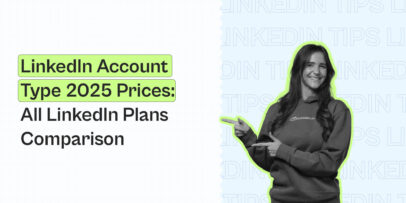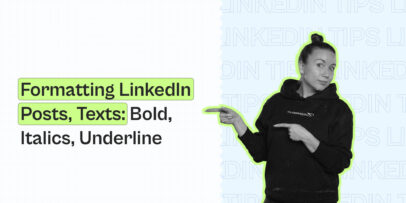LinkedIn Account Restricted: Here’s What to Do – Expandi

Your LinkedIn account got restricted and don’t know what to do?
Even if you did everything right by the book…
LinkedIn can still restrict your account.
If your LinkedIn temporarily restricted, or you got banned from LinkedIn, or simply received a suspension, there are several actions you can take right now to prevent this from happening again and to protect your account.
And below, we’re going to cover all scenarios.
So, if you’re wondering why LinkedIn temporarily restricted your account, here’s what you need to know:
- Your LinkedIn Account Has Been Restricted – 5 Common Reasons Why
- Best Safety Practices to Avoid Getting Banned on LinkedIn
- 2 Don’ts When Your Accounts is Restricted
- 2 Do’s When Your Account is Restricted
- LinkedIn Account Recovered – What to do Next
What Does it Mean My LinkedIn Account Is Restricted?
You’d think this would be pretty obvious. But that’s not the case as LinkedIn isn’t always clear on this.
Sometimes, you can even get your LinkedIn account restricted unknowingly.
According to LinkedIn guidelines, users have to:
- Use their real identities.
- List accurate information.
- Maintain platform integrity.
If LinkedIn believes you violated their community guidelines, they may suspend your account at some point, if not immediately.
What’s the difference between LinkedIn account restricted or suspended?
With account restriction, you typically can get your LinkedIn back after a 4-step process.
Meanwhile LinkedIn suspension is a permanent account ban or an endless loop of review of processes.
If your LinkedIn account is temporarily restricted, you may not be able to use certain features but you can typically regain access (see below).
Ending up as a permanent suspension only happens in more extreme situations though.
If you’re wondering why my LinkedIn account is restricted and what you can do next, keep on reading.
Why Is My LinkedIn Account Temporary Restricted? 5 Common Reasons Why
So, LinkedIn temporarily restricted your account, how come?
Well, don’t worry, this doesn’t even mean you necessarily did something wrong.
And chances are, if access to your account has been temporarily restricted, you can still get it back. If LinkedIn thought you were doing something wrong, they could have banned you directly.
This just means LinkedIn temporarily restricted your account as a precaution or warning.
Some of the most common reasons why LinkedIn may have restricted your account include:
- Sending too many connection requests.
- Having a low acceptance rate.
- Trying to connect with people you don’t know personally or have nothing in common with.
- Using dangerous LinkedIn automation tools.
- Inappropriate, illegal, spammy activity coming from your LinkedIn account.
Let’s take a look at each reason in detail to see if you’ve been doing anything that warrants a LinkedIn-restricted account.
What if you ARE banned from LinkedIn?
Keep on reading. We’ll cover this scenario below.
1. Too many connection requests
When building a LinkedIn network, it is recommended to have many connections. While it would seem strange to have 2000 Facebook friends, it is normal to have 2000+ LinkedIn connections.
However, this can quickly become an issue: if you try to build your profile too fast, LinkedIn might sanction you.
While it is OK to add 2000 connections as time goes by, spamming hard on the “connect” button just after you created your profile( or after months or even years of inactivity) will trigger the algorithm, resulting in restrictions.
Therefore, work on growing your profile, but do it in moderation. It’s generally recommended to keep an average of up to 20 connections per day. If you just created your profile, it will be wise to keep things under control, and add more people as your profile grows, which brings us to…
2. Low acceptance rate
A low acceptance rate is usually directly intertwined with too many connection requests. While it’s true that you first need to request a connection in order to get accepted, that doesn’t mean you should try to connect with everyone.
At first, while your profile is still growing, look to connect with people within the same industry. Suppose you are a WordPress developer, for example. In that case, you can connect with other developers but also managers working at IT companies, HRs, and even SEOs you can work with.
But, it would make no sense to start branching out to doctors and dentists at first, even if you plan to build websites for their offices. This is especially true if you try to pitch an offer straight in the connection request – that often looks too salesy, and you end up ignored, hurting your acceptance rate.
While you want to grow your network, you should do so without LinkedIn temporarily restricting your access.
3. Too many ‘I don’t know this person on your invitations
When people ignore your connection request, they have the “I don’t know this person” option to click.

If too many potential connections decide to do so, LinkedIn will get a clear sign that you are not building a “natural” network but forcing connections you don’t know and have nothing in common with.
Therefore, try to build an organic network, at least at first.
As your profile grows and gains traction, it will naturally start going in different directions, as other people will add you too.
Simply having a bigger network is a great way to reduce the chances of a LinkedIn restricted account. As you add more people, you’ll have more and more mutual connections with potential leads.
If they see you’re connected with a person they trust, they’re more likely to connect with you as well.
All of that will allow you to expand directly to potential clients, but it does require time.
Now, let’s get to the most common reason people are banned from LinkedIn.
4. Using dangerous LinkedIn automation tools (This is far too common! Don’t worry, we’ll help you with this below.)
The three steps from above are easy to follow but require time and dedication. Because it is so easy to forget to log in and search for connections every day, people lean towards LinkedIn automation tools, hoping to hack the process and eliminate the hassle.
The trouble is not all LinkedIn automation tools are the same. If you pick the wrong one, it can only escalate the problem, adding too many connections that have nothing to do with your profile and spamming them with cookie-cutter messages, even in the request itself.
Therefore, double-check any automation tool you plan to use if you want to avoid searching “why has LinkedIn blocked my account?” in the LinkedIn help online portal.
According to the LinkedIn Terms of Service, here’s what LinkedIn says about the risk of having your account restricted or shut down.

This doesn’t mean all marketing tools can lead to a restricted LinkedIn account.
While LinkedIn isn’t a huge fan of you automating your activity, it’s generally considered safe as long as you don’t overdo it.
5. Inappropriate, illegal, or spammy activity coming from the account
As you can see, all five reasons why your LinkedIn account might get suspended share one thing in common – suspicious, un-human-like activities. This doesn’t only mean growing your profile but also in your day-to-day use.
This is also the most common reason people get banned from LinkedIn.
If your profile sends too many repetitive messages to a wide variety of connections daily while simultaneously viewing an enormous amount of profiles, it will get the attention of LinkedIn police. If you combine that with adding random connections and ending up on the ignore list, don’t get surprised when you end up banned from LinkedIn.
Other reasons for LinkedIn account restriction here may include content, profile, identity, and automated tool violations, according to LinkedIn.
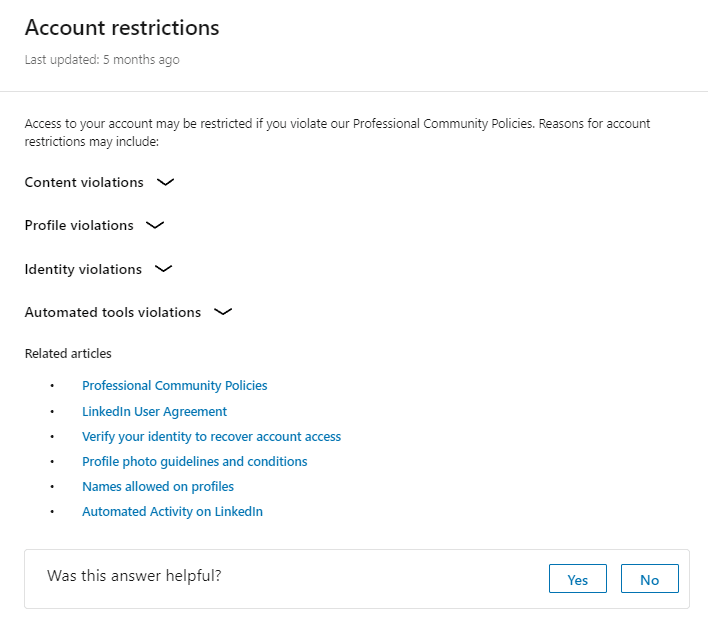
In a nutshell, LinkedIn wants you to be a “healthy” user of the platform. That means, improving your LinkedIn profile, not using obvious automation, and not harassing or spamming people.
Now, you might be wondering – “LinkedIn blocked my account. What do I do now?!”
Ideally, by following the best practices below, you won’t even get to that stage.
“What if it’s too late for that and I already got my LinkedIn temporarily restricted?”, you might be asking?
Skip ahead to the next section where we’ll cover this in more detail below.
Honestly, the best way not to get banned is to use safe, and tested LinkedIn practices – take it from us. So, if you’re wondering how to generate leads on LinkedIn without getting banned, check out our huge guide on this here – How to Generate Leads Through LinkedIn Automation Tools Without Getting Banned
Now, here are some other best practices and tips to avoid LinkedIn restricting your account.
5 Best Safety Practices If You Got Your LinkedIn Temporarily Restricted
Luckily, there is always a LinkedIn account restricted solution you can try to save your profile.
However, even if your account is NOT restricted, it might be well on the way to getting flagged.
Or if you just want to ensure your account stays safe, it’s always a good idea to take some safety measures and have an idea of some of the best LinkedIn practices.
The safety measures to avoid getting suspended on LinkedIn we’ll be looking at below include:
- Choosing your LinkedIn connections wisely.
- Always customizing and personalizing connection requests.
- Creating valuable content to show LinkedIn and users on the platform you’re a real person and not a bot.
- Using the right LinkedIn tools that mimic human behavior so that your activity doesn’t stand out.
Let’s cover each scenario in detail with examples.
1. Choose your connections wisely (at least initially)
Until your profile gains traction, play it conservatively, and add only connections that have something to do with your current position.
Especially considering that most people can send around 100 requests per week, because of the new LinkedIn connections limit. So, you’ll want to get the most out of the requests you do send.
Of course, you should start by adding people you know personally. After that, add connections who worked at the same company, went to the same school, or are within the same broader industry but live and work at the same location.
It’s also a good idea to branch out horizontally (by adding people at the same level as you, doing similar jobs) and vertically (by adding connections that would be higher/lower in the corporate chain compared to your current position).
Optimize your LinkedIn profile, use personalization, create quality content, and you’ll have a much better connection acceptance rate over time.
Essentially, if you’re overdoing sending connection requests, you might get your LinkedIn temporarily restricted. Make sure your connections are relevant, personalized, and under the current limits of 100 per week.
2. Customize connection requests
This is something you should be doing in general, not just as a precaution to prevent being locked out of LinkedIn.
The worst thing you can do is to send lifeless, bot-like connection request pitches – those will end up in the ignore list more often than not.
Instead, come up with something unique, and start a conversation. You will get to the pitch later after you establish initial contact.
As long as you pick connections mindfully, you won’t need to write connection request messages every single time if you don’t want to – you can start the conversation after they accept.
If you’re sending requests like this with no personalization, almost no one is going to connect with you. While this may not directly lead getting your LinkedIn account restricted, it’s likely that LinkedIn might think you’re a bot.
Here’s an example.
Bad LinkedIn connection request:
“Hey {first_name},
Love the work you do.
I help businesses like yours get more leads to scale.
Let’s connect so I can tell you more about what I do?”
Good LinkedIn connection request:
“Hey {first_name},
Saw your post about skyrocketing your reply rates by combining LinkedIn and email! That was super creative.
I just created a guide my sales team uses to safeguard their LinkedIn. Want to have a look?
Either way, would love to connect to keep up with your posts.”
3. Share valuable content and interact with others’ posts
If you only use LinkedIn to add and pitch connections without posting anything or interacting with content other people create, you risk getting your LinkedIn temporarily restricted.
To prevent it, share relevant content on your profile. That can be anything related to your industry, but it can be fun, work-related stuff as long as it remains somewhat professional. Try to make posts engaging by asking questions or posting thought-provoking stuff that will naturally spark curiosity and draw attention.
The same goes for reacting to other people’s content – like and share when you see something interesting and relevant and leave your opinion when you have something valuable to share in the comments section.
This doesn’t have to be complicated, as long as you’re using the right LinkedIn content strategy. If you send someone a connection request, and they then go back to your profile and see you’re regularly creating quality content, they’re going to be more likely to connect.
4. Maintain a balanced profile activity
Ensure your profile activity is balanced and doesn’t show signs of spammy behavior.
Avoid excessively sending connection requests, messages, or endorsements in a short period.
Engage in a variety of activities, such as posting updates, liking content, and participating in group discussions, to present a well-rounded and genuine presence on LinkedIn.
Make sure your LinkedIn profile is optimized and that you’re also posting content consistently if you want to maintain a balanced profile activity.
If your profile looks suspicious and you’re only sending messages all day, LinkedIn (as well as other people) might be more likely to think you’re a bot.
It’s all about being a “healthy” user.
5. Using the Right LinkedIn Tools
A far too common reason why people get banned is that they’re using all the wrong tools.
Yes, LinkedIn automation is all the rage these days, but that doesn’t mean you should just go with the very first tool you find.
Here’s the thing – there are two types of LinkedIn tools available:
- Chrome-based ones, and cloud-based ones. (We already covered this more in-depth here – 5 Essential Steps to Prepare Before Launching an Automated LinkedIn Outreach Campaign, but here’s a brief overview).
▪️ Chrome-based LinkedIn Tools
Chrome-based tools basically live in your browser.
Meaning, you open up LinkedIn from your favorite browser (e.g. Chrome), and then you fire up your tool in the form of an extension.
They then work from your browser (i.e. it’s not 24/7, you have to activate it each time manually, use browser cache (easier for LinkedIn to detect), and don’t offer dedicated IP addresses (meaning, your IP is different each time. If you’re logging in from different countries each time, this might set off a few alarms).
And this is just talking about things from a safety perspective. Chrome-based LinkedIn tools also lack some advanced features which make your life a lot easier (and safer!)
P.S. See how Expandi compares to one of the most popular Chrome-based LinkedIn tools here: The Best Alternative to Dux-Soup
▪️ Cloud-based LinkedIn Tools
Long story short – cloud-based tools work online and are safer than browser-based tools.
Why’s that, you ask?
It’s because:
- They offer a dedicated IP, so that your LinkedIn login info is consistent each time.
- It’s harder for LinkedIn to detect because it’s not front-end (like the browser tools).
- Advanced features (working days/hours limits, personalized messages, higher conversion rates, etc.) that allow for more personalization, and this in turn, makes your outreach efforts less spammy.
Note: If your conversion rates are high and you’re getting a lot of engagement – you’re off to a good start. It’s easier for LinkedIn to detect spammy and low quality messages, so, be sure to always work on your outreach skills.
Your outreach efforts play a big part in your account safety. If your messages sound like spam, then they probably are! Check out our outreach guide for beginners, as well as proven message templates you can use here: LinkedIn Outreach Guide for Beginners – 7 Essential Rules to Keep in Mind
Looking for the best LinkedIn tools that won’t have you banned from LinkedIn? See our full guide on LinkedIn automation for more info.
Now, worst case scenario – you got locked out of LinkedIn or banned from LinkedIn.
Let’s take a look as to what happens then and what you should do in that case.
3 Don’ts If You Got Your LinkedIn Temporarily Restricted
If you’re thinking “I’m banned from LinkedIn and there’s nothing I can do now!” – you’re wrong and there might be hope just yet.
If you got your LinkedIn account restricted or banned – for one reason or another, it’s not the end of the world.
Most people jump into creating a new account straightaway, hoping LinkedIn won’t notice.
It’s very important you do NOT do this. While there’s a very small chance LinkedIn might not notice (e.g. if you use a VPN), it’s always better to reverse the LinkedIn account restriction.
Just follow the steps below.
When it comes to what to do if LinkedIn account is restricted, first things first:
1. Don’t Panic
Take a deep breath.
It’s not the end of the world.
And depending on the type of response you get from LinkedIn, you can still recover your account.
Note: Depending on your account or activity, LinkedIn might give you a warning first. In that case, disconnect any tools you’ve been using (if any), and refrain from sending a lot of connection requests or messages. Take it slow, and work on warming up your account again.
2. Don’t Create a New LinkedIn Account
Sounds contradictory?
When you see a message from Linkedin your account is restricted, you just create a new one, right?
That’s where you’d go wrong.
LinkedIn will just detect a new account from your IP, and restrict that one as well. And they might give you a permanent ban as well for trying to play against the rules!
Note: Just because you might be able to create 2 LinkedIn accounts associated with 1 IP address – we would NOT recommend it. From a practical view, you will most likely never need 2 profiles, and from a safety standpoint, LinkedIn will probably figure it out and think you’re up to no good.
From LinkedIn User Agreement: You agree that you will not: Create a false identity on LinkedIn, misrepresent your identity, create a Member profile for anyone other than yourself (a real person), or use or attempt to use another’s account…
3. Don’t ignore LinkedIn ID requests
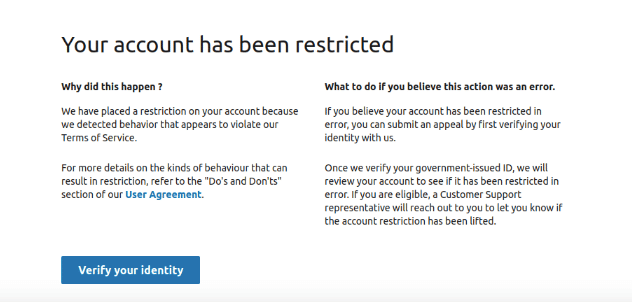
You might be thinking, I got my LinkedIn temporarily restricted, when will I get it back?
Sometimes, you might get a temporary account restriction with an ID request. If that is the case, LinkedIn suspects your account is used by a bot, probably due to message spam or similar suspicious behavior.
This restriction is much more serious than a regular warning you get when you reach your weekly limits, so don’t gamble. Provide LinkedIn help with the requested information, and ensure you comply with the rules after they give you back access.
That means taking it easy and slow without using any automation tools. Follow the rules to avoid risking a permanent ban.
So, what should you do instead?
Probably contact LinkedIn directly and confess your sins?
Maybe, but before you do that, here’s what you need to know:
2 Do’s When Your Account is Restricted
Now, if you’re here, chances are, access to your account has been temporarily restricted.
Wondering how to recover restricted LinkedIn account?
This part will be important, so make sure you pay attention.
1. Disconnect Any and All LinkedIn Tools
Officially, MOST LinkedIn tools (automation or otherwise) go against their Terms of Service.
Even if your account got restricted for some other reason – you should disconnect any LinkedIn tools associated with your account (remove access, log out from everything, if needed, delete account), and clear your browser cache.
From LinkedIn Prohibited Software and Extensions page: “We don’t permit the use of any third party software, including “crawlers”, bots, browser plug-ins, or browser extensions (also called “add-ons”), that scrapes, modifies the appearance of, or automates activity on LinkedIn’s website…”
Once you do that, try logging in again in a few days.
If your account is still restricted, there’s only one thing left to do…
2. Time to Contact LinkedIn
Now, it’s finally time to contact LinkedIn.
You can’t escape this, so might as well give it your best.
One common problem many people have is actually finding LinkedIn help online restricted account information..
We’re just going to save you a whole lot of time.
Here’s the LinkedIn Contact Us Form you should use: https://www.linkedin.com/help/linkedin/ask/gri
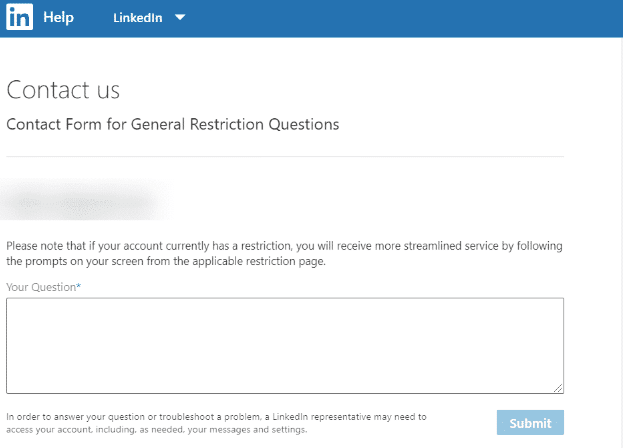
Note: You might be required to confirm your identity with some identification document. Have your passport, identity card, or driver’s license ready just in case.
Once there, write what happened, how your LinkedIn account got restricted, and that you’re wondering what happened.
A couple of tips when writing the ‘contact us‘ form:
- Be honest – Say if you created a new account, and get to the point.
- Don’t mention LinkedIn tools – If you used them, they already know about it. If you didn’t it doesn’t make a difference.
- Focus on recovering the account – You want to find out two things here: why is my linkedin account restricted in the first place, and how to recover it and move forward.
There are 2 potential outcomes here:
- You don’t get your account back and/or they don’t reply – in which case, try again in a month or two.
- Your account is recovered. Here’s what to do in that case…
LinkedIn Account Recovered – What to do Next
Congratulations!
Great news, you got your account back!
That’s nice and all, but you’re still on thin ice with LinkedIn.
If you mess up here, your restriction might lead to a permanent ban.
Here are a couple of tips you should keep in mind after the LinkedIn restricted account recovery:
1. Warm Up Your LinkedIn Account From Scratch
Pretend the account your recovered is completely new, and use the best outreach safety practices:
- Stick to a few manual connection requests per day, and slowly start building them up.
- Try to only connect with people you have mutual connections with.
- Send personalized, custom, engaging private messages that don’t sound very sales-y.
- Delete old and pending LinkedIn connection requests.
- User personalization – a lot of it!
We covered warming up your LinkedIn account in more in-depth before. Check out the details as well as the other safety tips here: LinkedIn Outreach Guide for Beginners – 7 Essential Rules to Keep in Mind
2. Use Safe Tools
Want to start generating a ton of high-quality leads from LinkedIn again? This time in a safe way?
Well, it’s time to reconsider your tools.
If you’ve been using chrome-based tools until now – why not try cloud-based tools? They’re guaranteed to be much safer too, in addition to offering a ton of new LinkedIn features which help with leads and automation.
A lot of safety depends on how you’re using the tools.
So, if you’re looking for a less aggressive, safer, and more advanced LinkedIn lead generation guides (and case studies), be sure to check out the Expandi blog for the latest growth-hacking techniques and proven templates.
Safety is our number one priority.
So, a lot of the growth-hacking techniques and principles we cover are stuff we already tried and tested.
For better information go and visit our webinar so we could help you understand more.
Summary
Now, if you’re still wondering why is my LinkedIn account restricted, there are a few reasons why this might be the case.
To recap, the reasons for your account restriction may include:
- Sending too many connection requests.
- Not enough people connecting with you or them saying they don’t know you.
- Using dangerous LinkedIn automation tools that make you look like a bot.
- Inappropriate, illegal, or spammy activity coming from your account.
Now, if you’re thinking – “LinkedIn restricted my account still, what should I do?”
If that’s the case, here’s a quick recap for you:
- Make sure you’re using the latest and safest LinkedIn practices.
- If you were using any LinkedIn tools before – remove them.
- Treat your recovered account like new.
- Take a break before you start using safe LinkedIn tools (2-3+ months after recovering account).
- Do NOT start aggressive mass outreach campaigns. Take things slow and you’ll get to keep your account.
A lot of LinkedIn safety and account restrictions boil down to safe LinkedIn marketing and lead generation practices, and using the right LinkedIn tools. So, start there.
You’ve made it all the way down here, take the final step
